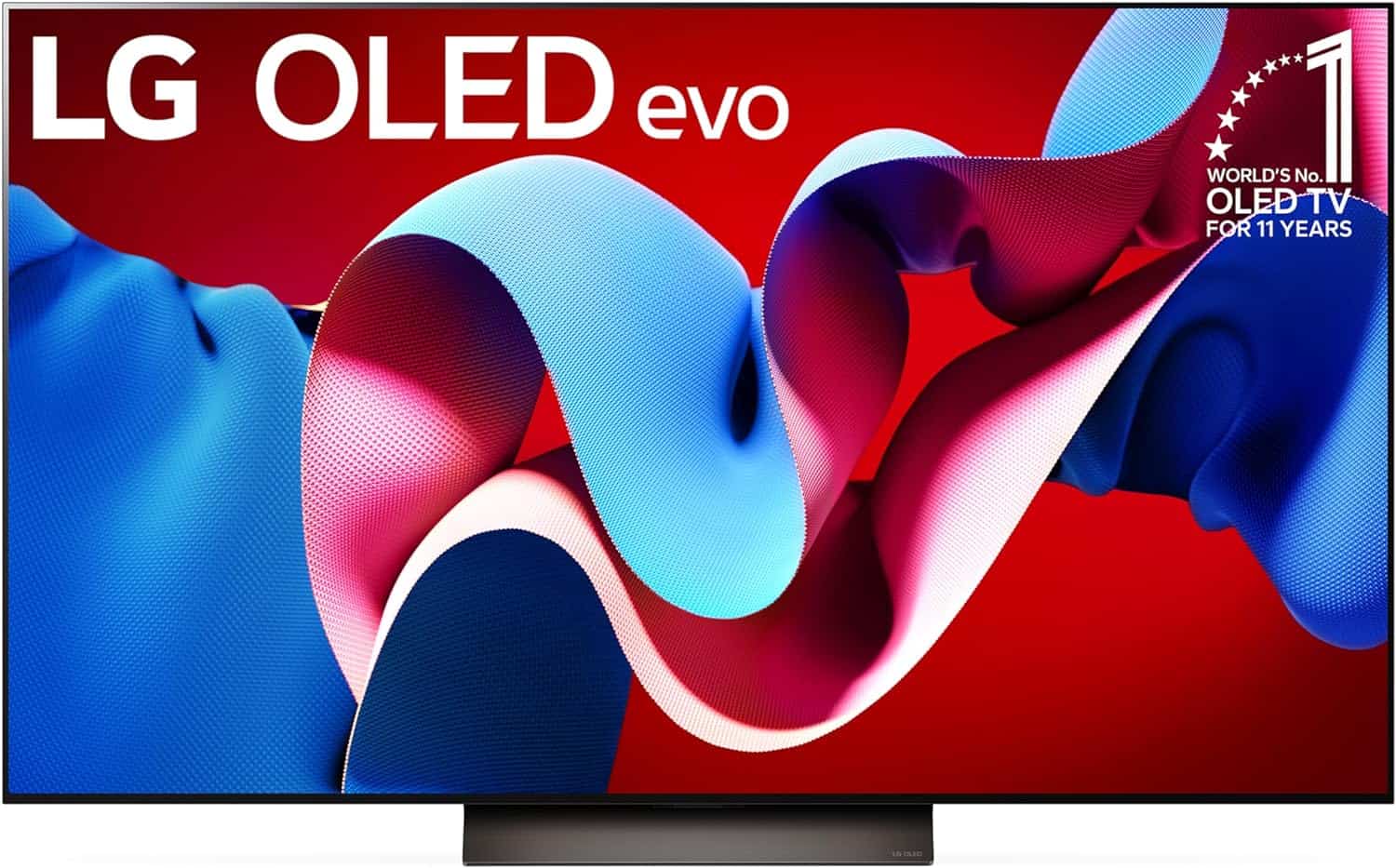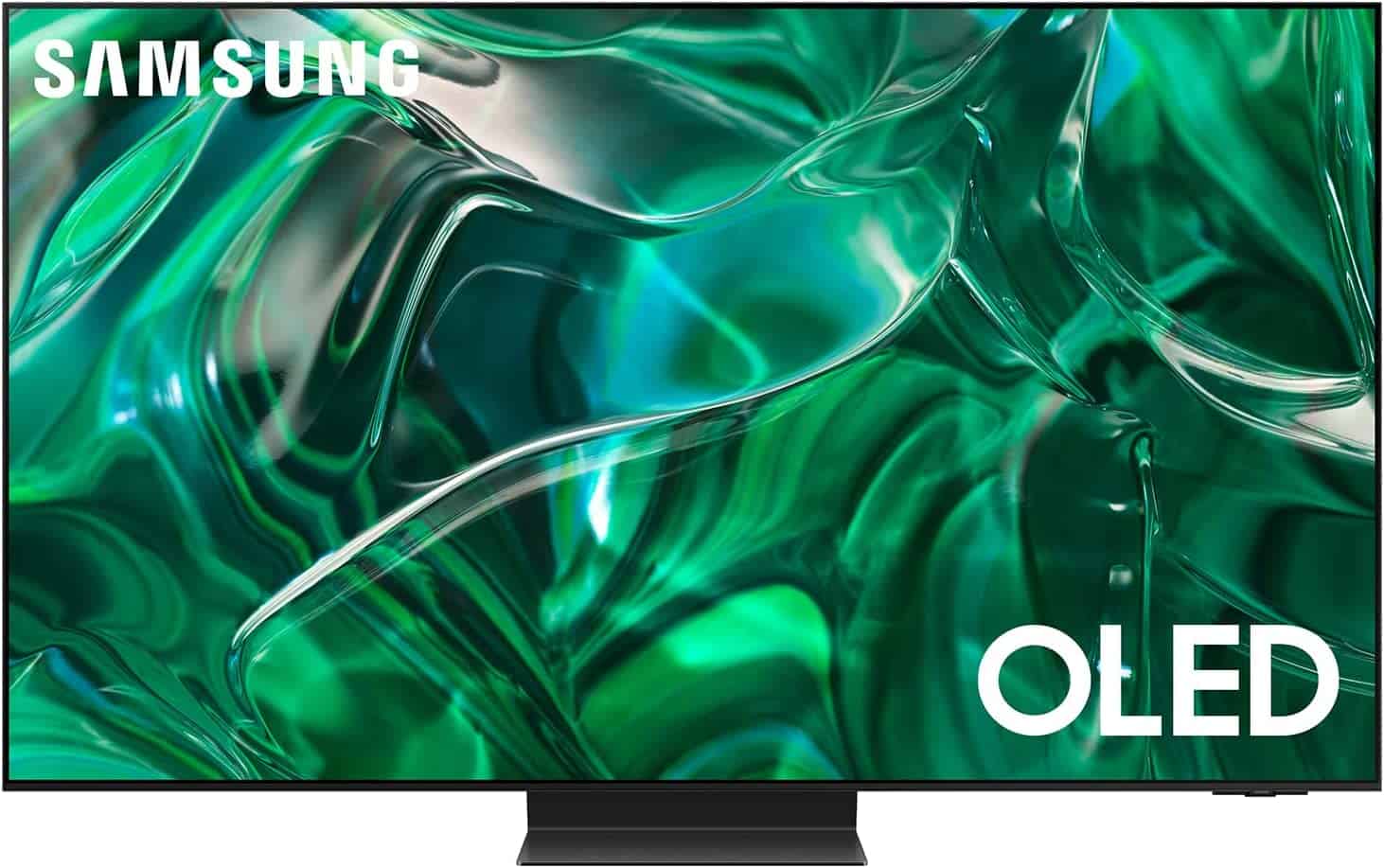
LG C4 OLED Series

Now up to 144Hz refresh rate at 4K
Highly responsive
Improved Alpha 9 AI chip
Native Chromecast support
Wide range of sizes
Still no MLA like the G-series
Not a massive upgrade over the LG C3
Another LG vs Samsung TV comparison - this time the C4 vs S95C

WePC is reader-supported. When you buy through links on our site, we may earn an affiliate commission. Prices subject to change. Learn more
Now that we have had our first look at the LG C4, it is time to compare the C4 vs S95C to see which one is better. The LG C4 uses its brand-new Alpha 9 Gen-7 AI panel to bring exceptional brightness to the table. This gaming TV can get really bright even in well-lit rooms and does not suffer from reflections as much as its predecessor.
Similarly, being a high-end Samsung TV from 2023, the S95C delivers amazing picture quality with excellent colors at all times. It uses the second-gen QD-OLED display and is one of the best OLED TVs to ever exist.
With HDMI 2.1 ports and support for a high refresh rate, both TVs are excellent gaming candidates, but one is destined to be superior. To find out which, we will be comparing the LG C4 against the Samsung S95C in terms of display, sound, performance, and even pricing.


Now up to 144Hz refresh rate at 4K
Highly responsive
Improved Alpha 9 AI chip
Native Chromecast support
Wide range of sizes
Still no MLA like the G-series
Not a massive upgrade over the LG C3


Top-notch colors and picture quality
Stunning second generation QD-OLED panel
Wide viewing angle
Streamlined cable management
Up to 144Hz refresh rate
40Gbps HDMI with One Connect Box
Expensive
| Specification | LG C4 | Samsung S95C |
|---|---|---|
| Panel type | OLED evo | QD-OLED |
| Size range | 42″, 48″, 55″, 65″, 77″, 83″ | 55”, 65”, 77” |
| Resolution | 3840 x 2160 (4K) | 3840 x 2160 (4K) |
| Refresh rate | 144Hz | 144Hz |
| Processor | Alpha 9 AI | Neural Quantum Processor 4K |
| HDMI standard | 4x HDMI 2.1 | 4x HDMI 2.1 |
| VRR | HDMI VRR, AMD FreeSync, NVIDIA G-Sync | HDMI VRR, AMD FreeSync, NVIDIA G-Sync |
| HDR | Dolby Vision / HDR10 / HLG | HDR10+ / HDR10 / HLG |
Starting with the panel and display quality, the S95C uses a QD-OLED panel, while the C4 uses OLED evo technology. Basically, the S95C’s panel uses quantum dots to emit colors in order to boost brightness when compared to traditional OLED panels. Similarly, the C4’s OLED evo panel combines the efficiency of its Alpha 9 AI chip to boost the highlights, again resulting in a brighter display.
However, if we compare the two displays, the Samsung S95C wins in terms of overall display quality. It is not only a bright display, but it is also an overall better option. The S95C’s color gamut coverage is exceptional, and the colors on this TV can really pop with brilliant vibrance.
Moving on to sound, the LG C-series has always suffered from inferior audio quality, and we always recommend pairing them with a soundbar for optimal experience. While the C4 offers AI Sound Pro that delivers a virtual up-mix of 9.1.2-channel audio and a wireless, lossless Dolby Atmos experience, it is still not as good as the S95C. The Samsung S95C sounds punchier and overall more immersive with its Object Tracking Sound+ feature.
As for HDR, the C4 is slightly better with its support for Dolby Vision, but the S95C is not bad at all as it supports HDR10+, something the latest flagship OLED successor also sticks to. However, if we talk about HDR movies, the S95C will deliver a premium experience thanks to its better display quality.
One thing the C4 excels at is its AI upscaling, especially at low-res content like 480p TV shows. The Alpha 9 AI chip inside the C4 does a great job at upscaling content to 4K, so if you regularly watch low-res TV shows, the C4 will perform better than the S95C.
Lastly, the design of the S95C is also better as it uses the external Slim One Connect Box. Therefore, you can hide the input cables away from the TV and enjoy a cleaner look with less cable clutter. However, the box does only supports 40Gbps bandwidth rather than the full 48Gbps that HDMI 2.1 offers, which has reportedly caused dropouts for HDR content at 4K 144Hz.
| Size | LG C4 | Samsung S95C (March 2024) |
|---|---|---|
| 83” | $5,399.99 | N/A |
| 77” | $3,699.99 | $3,499.99 |
| 65” | $2,699.99 | $2,299.99 |
| 55” | $1,999.99 | $1,799.99 |
| 48” | $1,599.99 | N/A |
| 42” | $1,499.99 | N/A |
Despite being a high-end 2023 TV, the Samsung S95C is more affordable than the LG C4 at the time of writing, which is meant to be a more bang-for-your-buck option.
The main reason behind such a surprising price difference is that the S95C has been out for some time, and in fact, it will soon be replaced with the Samsung S95D. That’s why it has seen major price cuts over the months and will continue to do so as we approach deal seasons like Prime Day and Black Friday.
Nevertheless, comparing the current prices, the Samsung S95C takes the win as it costs a couple of hundred dollars less than the C4, though we should also see the C4 soon drop off. Looking back to the launch prices of the S95C, it was of course considerably more than the C4.
When it comes to gaming, both TVs compete neck-to-neck, and there are a lot of similarities between them. For instance, both of them have a high refresh rate of 144Hz, come with 4x HDMI 2.1 ports, and plenty of VRR support with AMD FreeSync, NVIDIA G-Sync, and HDMI VRR. So you get the smoothest possible gaming experience at all times.
On paper, the LG C4 has an impressive response time of <0.1ms, and we already know the S95C’s response time is quite instantaneous, just like its low input lag.
For console gamers, though, the S95C might be the way to go because of its better display quality and richer colors. But if size matters to you and you prefer something more compact, the LG C4 could be your pick since it’s available in 42” and 48” models, which are sizes gamers often lean towards for desktop use. Bandwidth limitations of the S95C’s One Connect Box can also cause problems at 144Hz, in particular for 4K HDR gaming.


Sizes
42″, 48″, 55″, 65″, 77″, 83″
Screen technology
OLED
Resolution
3840 x 2160 (4K)
Refresh rate
144Hz
Panel type
WOLED
HDMI standard
HDMI 2.1


Sizes
55″, 65″, 77″
Screen technology
QD-OLED
Resolution
4K Ultra HD 3840 x 2160p
Refresh rate
144Hz
Panel type
OLED
HDMI standard
HDMI 2.1
Overall, we would recommend the Samsung S95C over the LG C4, primarily because it is a better option across the board while also costing $100 to $200 less as of March 2024. Its QD-OLED panel delivers top-notch brightness with brilliant colors, and the Object Tracking Sound+ brings a level of audio immersion that the C4 simply does not offer – it remains one of the best QD-OLED TVs.
Of course, the C4 is not necessarily a bad option. In fact, if you want the latest TV that offers more sizes and is a solid all-rounder, we would suggest the LG C4. It is perfect for gaming with its high refresh rate display and low response time.
While we don’t yet have exact brightness values for the C4, it does offer a higher peak luminance than the C3. Looking back to the C3 vs S95C, we could see that the Samsung TV was brighter in HDR, but the LG was marginally better in SDR. Current predictions place the C4 at around 200 nits brighter than its predecessor, which will help it close the gap to the S95C.
However, since the C4 is still not getting the same MLA tech as the G-series and is sticking to the same OLED evo panel type, any brightness boosts are from the improved processor. This makes for a more incremental chance, so we expect the S95C to remain the brightest for HDR content.
We’ve come to the end of our LG C4 vs Samsung S95C comparison, and it looks like the Samsung television holds on as the winner in a range of ways. It is the flagship model from 2023, so we shouldn’t expect a mid-range 2024 model to simply overtake it so easily.
In terms of value for money, the S95C is actually an excellent choice give recent price drops, but we expect the C4 to soon drop below it – see our where to buy LG C4 OLED TV guide while you’re here.